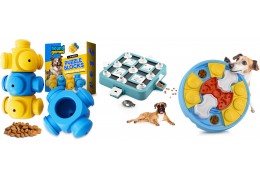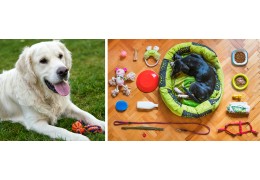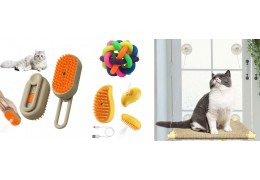Choosing the right small pet carrier is essential for your pet’s safety and comfort during travel. This guide...
Why Regular Ear Cleaning is Crucial for Your Dog’s Health
Keeping your dog’s ears clean is essential for their overall health and well-being. Many pet owners overlook this aspect of grooming, but neglecting ear hygiene can lead to serious problems, including infections, hearing loss, and chronic discomfort. Using a dog ear cleaning tool regularly helps prevent these issues by removing wax buildup, dirt, and bacteria before they cause complications. Whether you have a floppy-eared breed prone to infections or a short-haired dog with open ear canals, maintaining proper ear hygiene is crucial for preventing unnecessary veterinary visits and ensuring your pet stays comfortable and happy.
Why Do Dogs Need Regular Ear Cleaning?
Dogs rely on their hearing to navigate the world, communicate, and stay safe. Unlike humans, dogs have a unique ear structure with deep, L-shaped canals that make it easy for dirt and moisture to get trapped inside. Over time, this can lead to the growth of harmful bacteria and yeast, resulting in painful infections.
Some signs that your dog’s ears need cleaning include:
• Frequent head shaking
• Scratching at the ears
• Unpleasant odor coming from the ears
• Redness or swelling
• Brown, yellow, or black discharge
Ignoring these warning signs can lead to serious infections that require medical intervention. By incorporating a dog ear cleaning tool into your pet’s grooming routine, you can prevent these issues before they escalate.
Common Causes of Ear Infections in Dogs
Several factors contribute to ear infections and wax buildup in dogs, including:
1. Breed and Ear Shape
Some breeds, such as Cocker Spaniels, Basset Hounds, and Golden Retrievers, have long, floppy ears that restrict airflow and create a warm, moist environment for bacteria to thrive.
2. Excessive Wax Production
Some dogs naturally produce more earwax than others. If not removed, excess wax can lead to blockages, irritation, and infection.
3. Allergies
Dogs with food or environmental allergies often experience inflammation that affects their ears. This can lead to chronic itching, redness, and infections.
4. Water Exposure
Moisture from swimming or bathing can get trapped in a dog’s ears, promoting the growth of yeast and bacteria. This is especially common in breeds that enjoy water activities.
5. Parasites
Ear mites are a common problem, especially in puppies. These microscopic parasites cause intense itching, leading to excessive scratching and secondary infections.
Regular use of a dog ear cleaning tool can help remove wax, debris, and moisture, reducing the risk of infections and complications.
How to Properly Clean Your Dog’s Ears
Cleaning your dog’s ears doesn’t have to be a difficult task. Follow these steps to ensure a safe and effective cleaning process:
1. Gather Your Supplies
o A high-quality dog ear cleaning tool
o Vet-approved ear cleaning solution
o Cotton balls or gauze
o Treats for positive reinforcement
2. Examine Your Dog’s Ears
Before cleaning, inspect your dog’s ears for any signs of infection, swelling, or an unusual smell. If you notice anything abnormal, consult your veterinarian before proceeding.
3. Apply the Cleaning Solution
Gently lift your dog’s ear flap and apply a few drops of ear cleaning solution into the canal. Be sure to follow the product instructions to avoid overuse.
4. Massage the Ear Canal
Massage the base of the ear for about 30 seconds to help the solution break up debris and wax buildup. You might hear a squishing sound—this is normal.
5. Wipe Away Debris
Using a dog ear cleaning tool, cotton ball, or gauze, gently wipe out any loosened debris. Never use cotton swabs, as they can push debris further into the ear canal.
6. Let Your Dog Shake
Allow your dog to shake their head to help dislodge any remaining solution and debris.
7. Reward Your Dog
Praise and reward your dog with a treat to create a positive experience, making future cleanings easier.
How Often Should You Clean Your Dog’s Ears?
The frequency of ear cleaning depends on several factors, including breed, activity level, and ear health. In general:
• Dogs prone to infections (e.g., floppy-eared breeds) may need cleaning once a week.
• Active dogs who swim often should have their ears cleaned after every swim to remove trapped moisture.
• Dogs with healthy ears and no wax buildup may only need cleaning once a month.
Over-cleaning can strip the ear canal of its natural defenses, so it's important to find the right balance. Using a dog ear cleaning tool regularly but not excessively is key.
Choosing the Right Dog Ear Cleaning Tool
Not all ear cleaning tools are created equal. When selecting the best dog ear cleaning tool, consider:
• Material – Choose soft, gentle materials that won’t irritate your dog’s ears.
• Ease of Use – Look for tools designed for easy handling and safe cleaning.
• Effectiveness – Opt for a tool that effectively removes wax and debris without pushing it further into the ear.
Many pet owners find that silicone-based ear wipes, reusable ear swabs, or ear cleaners with ergonomic designs work best. Avoid using human ear cleaning products, as they may contain ingredients that are harmful to dogs.
The Risks of Neglecting Your Dog’s Ear Hygiene
Failing to clean your dog’s ears regularly can lead to a host of serious health problems, including:
• Painful infections that require antibiotics or medical treatment
• Hearing loss due to chronic inflammation and untreated infections
• Head shaking injuries that can cause hematomas (blood-filled swellings in the ear flap)
• Increased vet bills from treating preventable ear conditions
By using a dog ear cleaning tool as part of your pet’s grooming routine, you can avoid these complications and ensure your dog stays healthy and happy.
Conclusion
Regular ear cleaning is an essential part of responsible pet care. Dogs of all breeds and sizes benefit from clean ears, as it helps prevent infections, wax buildup, and discomfort. Investing in a quality dog ear cleaning tool and incorporating ear hygiene into your grooming routine will keep your pet comfortable and free from painful ear issues.
Take the time to check your dog’s ears regularly, and make ear cleaning a stress-free experience with gentle techniques and positive reinforcement. Your dog will thank you with a lifetime of wagging tails and happy, healthy ears.












